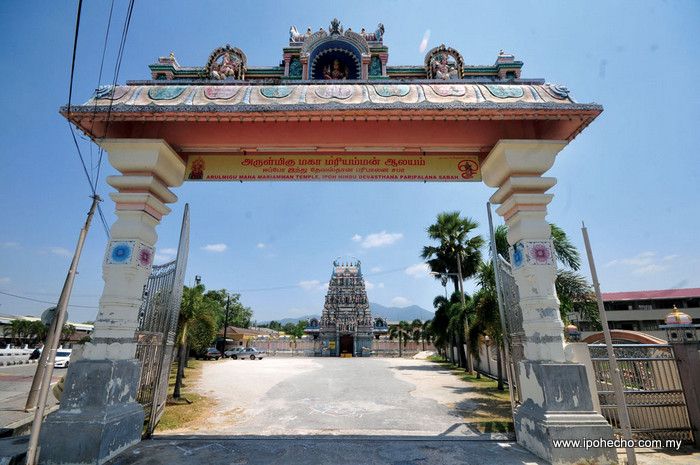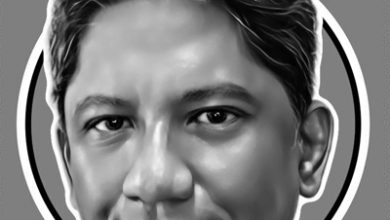Hindu Temples in Ipoh


Cover Story
By A. Jeyaraj
“Do not live in a place where there is no temple” (Kovil illatha uuril kudi iruka veendaam).
This is a popular saying in Tamil. So wherever Hindus went and settled, the first thing they did was build a temple to make the place liveable. In Ipoh alone, there are more than 30 registered Hindu Temples; and according to V.M. Thiagarajan, former Chairman of Malaysia Hindu Sangam, Perak Branch, if unregistered temples are included, the number would be more than 80. Ipoh Echo went in search for some of the more popular temples to learn about their main deities, activities and festivals.




Temples, Shrines, Deities and Festivals – each a feast of stories steeped in mythology
Each temple has a main deity and Murugan, both the youthful God of War and the patron deity of Tamil Nadu in South India, is the deity in many temples here. The plethora of deities in the Hindu pantheon can be dizzying and this article makes no attempt to explain the intricacies, mythology or ontology of Hinduism. For Hindus, temples are the most auspicious places of worship in order to lift one’s spirituality to the highest level possible. This is a brief overview of a few popular temples in and around Ipoh.
Temples – Beginnings
Most of the old temples began with the statue of a deity in a small shrine which is the karuvarai or inner sanctuary (sanctum sanctorum in Latin or Holy of Holies). When the temple is extended, other structures are added and eventually the typical gopuram or tower is built. For example, the karuvarai of the famous Meenakshi Amman Temple is a historic Hindu temple located on the southern bank of the Vaigai River in the temple city of Madurai, Tamil Nadu, India. This has been carbon dated to be more than 3500 years. The significance of a temple is often based on the number of poosai or prayer ceremonies performed per day; the maximum being six or aaru kala poosai.
Temple Activities
Ipoh Hindu Devasthana Paripalana Sabah was formed in 1952 to co-ordinate the activities of all the temples in Ipoh. Initially the Sabah functioned effectively, but when more temples were built, they did not join or comply with the requests of the Sabah. Now many temples have their own programme and celebrate the same festivals.
During festivals in addition to prayers and religious ceremonies, cultural activities like singing and dancing are performed. It is an occasion for adults and children to wear colourful traditional dresses. Additionally, most temples have free religious and Tamil classes on Sundays.


The temple was built in 1896 and with the main statue of Murugan consecrated inside the cave. This statue is still inside the cave, but a new and bigger statue has been installed and used during prayers.
The cave is U-shaped and as you climb the stairs there is a big space where the main shrine is built and when you walk along, the cave bends and steps lead to the ground. N. Rajasegaran, Secretary, Temple Committee informed that the main festival of the temple is Thaipusam which attracts a big crowd. This is the only Hindu cave temple around Ipoh which attracts many tourists.
Sri Thandayuthapani Alayam, Lahat Road
The main deity in the temple is Murugan and this temple is popularly known as Chettiar Kovil. M. Manickam Chettiar, Chairman, Temple Committee said that the temple is more than 120 years old. Its main festivals are Vaigasi Visagam which is celebrated for three days during May with a chariot procession, a day when Murugan incarnated in this world with the mission of saving earth from demons and Thirukarthigai Deepam which is a festival of lights and is observed on a full moon day in the month of November during which most Hindu homes put oil lamps in front of their houses.


Behind the temple is the popular Arasamarathu Pillaiyar or Pillaiyar under the peepal tree. Pillaiyar is the Elephant God and is known for removing obstacles from life and also bestowing material prosperity and wisdom to his devotees. This is a 24-hour shrine and devotees come and worship throughout the day and night.
Ipoh Sivan Kovil – Jalan Sungai Pari
The main deity in this temple is a Lingam which is aniconic (symbolic or suggestive rather than literally representational) representation of God Siva. A survey map of Ipoh published in 1896 lists this place as a temple. G. Thyagarajah, President, Temple Committee said that the temple must have been built before this year. Initially this was a Muniswarar Temple where animal sacrifice was practised, but this was stopped in 1953 and it was converted to a Saivite temple and vegetarianism is practised.




The main festivals include Maha Sivarathri which is celebrated for 12 days during the new moon in February/March where devotees keep awake throughout the night. According to legend, those who worship Siva on these auspicious days would be cleansed of all their sins. There is a chariot procession on the last day.
Aani Thirumanjanam is celebrated for 10 days during the Tamilmonth of Aani which falls in July. Thirumanjanam means ‘holy bath’ and the idol is bathed during twilight. On the last day a symbolic Sivan-Parvathy marriage takes place.
Sri Maha Mariamman Temple – Jalan Sungai Pari
The main deity is Mariamman meaning mother and her worship mainly focuses on bringing rains and curing diseases like cholera, smallpox, and chickenpox. B. Rajendran, Secretary, Temple Committee said that the temple was built in 1905 near the old Majestic Theatre and due to expansion of the town, it was relocated to the current place in 1914.




The main festivals here are Navarathri which is nine nights in September of celebration honouring God’s manifestation in the forms of the goddesses Durga, Lakshmi and Saraswathi. The festival is accompanied by music and dance and Aadipuram is celebrated in July with special prayers for Mariamman to seek her protection.
Sri Subramaniyar Temple, Gunung Cheroh


Another festival, Kantha Shasti is held for ten days in November. This festival depicts the victory of Murugan over the demon Soorapadman.
Sri Nadarajar Temple, Jelapang Road


Interestingly, there is a six-foot tall Nataraj statue at CERN (European Organisation for Nuclear Research) in Geneva. In the Hindu religion, this form of the dancing Lord Shiva is known as the Nataraj and symbolises Shakti, or life force. As a plaque alongside the statue explains, the belief is that Lord Shiva danced the Universe into existence, motivates it, and will eventually extinguish it. Carl Sagan drew the metaphor between the cosmic dance of the Nataraj and the modern study of the ‘cosmic dance’ of subatomic particles. This was a gift from India.
Lord Krishna Temple, Lahat Lane
The main deity of the temple is Lord Krishna. A wooden temple was built in 1920 and it was destroyed by fire during mid-forties.
The new temple was built after that. The temple mainly serves the North Indian Hindu community.




The main festivals are Janamasthami (Lord Krishna’s Birthday) which is celebrated during August/September. The celebration begins with recitation of Shreemad Bagwat Katha continuously for seven days prior to the celebration.
Another festival is Holi, a spring festival and also known as the festival of colours, celebrated during February/March. Holi celebrations start at night with a Holika bonfire where people perform religious rituals in front of the bonfire. After that Rangwali Holi begins, a free-for-all carnival of colours, where participants play, chase and smear coloured powder on each other.


